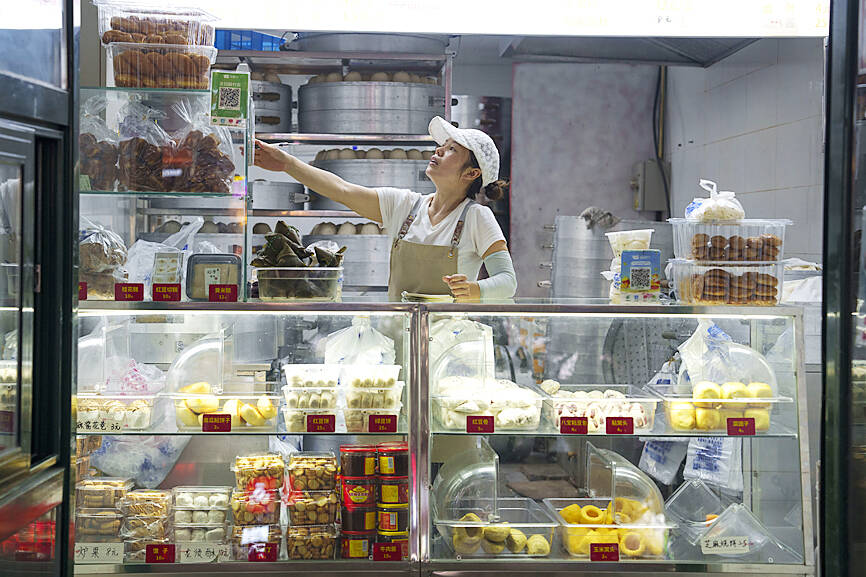Chinese officials yesterday acknowledged the sweeping list of economic goals re-emphasized at the end of a key Chinese Communist Party (CCP) meeting this week contained “many complex contradictions,” pointing to a bumpy road ahead for policy implementation.
Pressure for deep changes in how the world’s second-largest economy functions has risen this year, with consumer and business sentiment near record lows domestically, and global leaders increasingly concerned with China’s export dominance.
Following a four-day, closed-door meeting led by Chinese President Xi Jinping (習近平), which takes place about once every five years, officials made a raft of seemingly contradictory pledges, such as modernizing the industrial complex while expanding domestic demand to stimulate growth and simultaneously curb debt risks.

Photo: AP
The initial summary of the meeting, known as the “Third Plenum,” did not contain details on how Beijing plans to resolve the tensions between policy goals, such as how to get consumers to spend more while resources flow primarily to producers and infrastructure.
Concerns are growing that without a structural shift that gives consumers a greater role in the economy, debt would continue to outpace growth to finance Beijing’s industrial modernization and global prominence goals.
Some analysts say that Beijing’s economic path risks a prolonged period of near-stagnation and persistent deflation threats as seen in Japan since the 1990s.
“High debt levels plus increasing deflationary pressures eventually could result in a Japan-style ... low growth and very low inflation,” said Julian Evans-Pritchard, head of China economics at Capital Economics.
“That, I think, would force them to change course on their current policies. But that might not happen straight away. That might only happen in a few years’ time,” he said.
Contradictions in Chinese policy efforts have been present for decades, as were goals to increase manufacturing value added, enhance social security, liberalize land use and improve local government tax revenues.
However, making tough choices is an increasingly urgent task. China grew at a slower-than-expected pace in the second quarter this year, leaning hard on industrial output and external demand, but showing persistent domestic weakness.
Speaking at a media briefing yesterday along with other CCP officials, Tang Fangyu (唐芳雨), deputy director of the central committee’s policy research office, said Beijing was aware of the challenges.
“The deeper the reform goes, the more complex and acute the conflicts of interest it touches,” Tang said.
“Pushing forward Chinese-style modernization faces many complex conflicts and problems, and we must overcome multiple difficulties and obstructions.”
The EU Chamber of Commerce in China said it was “positive that China’s leadership has again acknowledged many of the headwinds facing the country’s economy,” but the outcome was largely “a reiteration of points.”
“There appears to be no deviation from [China’s] immediate priority, which is to balance its economic recovery against national security concerns, while maintaining social stability.”
China is expected to publish a document with more detailed policy plans in the coming days.
However, the fact that the initial post-plenum announcement borrowed heavily from China’s existing playbook disappointed some economists.
“Nothing new under the sun: the same industrial policies, the same sense of things,” said Alicia Garcia Herrero, chief economist for Asia Pacific at the French investment bank Natixis.
“Really no change in direction, no consumption-led growth, nothing. No sentence on the power of market forces, nothing. So, it’s really disappointing,” she added.

The US dollar was trading at NT$29.7 at 10am today on the Taipei Foreign Exchange, as the New Taiwan dollar gained NT$1.364 from the previous close last week. The NT dollar continued to rise today, after surging 3.07 percent on Friday. After opening at NT$30.91, the NT dollar gained more than NT$1 in just 15 minutes, briefly passing the NT$30 mark. Before the US Department of the Treasury's semi-annual currency report came out, expectations that the NT dollar would keep rising were already building. The NT dollar on Friday closed at NT$31.064, up by NT$0.953 — a 3.07 percent single-day gain. Today,

‘SHORT TERM’: The local currency would likely remain strong in the near term, driven by anticipated US trade pressure, capital inflows and expectations of a US Fed rate cut The US dollar is expected to fall below NT$30 in the near term, as traders anticipate increased pressure from Washington for Taiwan to allow the New Taiwan dollar to appreciate, Cathay United Bank (國泰世華銀行) chief economist Lin Chi-chao (林啟超) said. Following a sharp drop in the greenback against the NT dollar on Friday, Lin told the Central News Agency that the local currency is likely to remain strong in the short term, driven in part by market psychology surrounding anticipated US policy pressure. On Friday, the US dollar fell NT$0.953, or 3.07 percent, closing at NT$31.064 — its lowest level since Jan.

The New Taiwan dollar and Taiwanese stocks surged on signs that trade tensions between the world’s top two economies might start easing and as US tech earnings boosted the outlook of the nation’s semiconductor exports. The NT dollar strengthened as much as 3.8 percent versus the US dollar to 30.815, the biggest intraday gain since January 2011, closing at NT$31.064. The benchmark TAIEX jumped 2.73 percent to outperform the region’s equity gauges. Outlook for global trade improved after China said it is assessing possible trade talks with the US, providing a boost for the nation’s currency and shares. As the NT dollar

The Financial Supervisory Commission (FSC) yesterday met with some of the nation’s largest insurance companies as a skyrocketing New Taiwan dollar piles pressure on their hundreds of billions of dollars in US bond investments. The commission has asked some life insurance firms, among the biggest Asian holders of US debt, to discuss how the rapidly strengthening NT dollar has impacted their operations, people familiar with the matter said. The meeting took place as the NT dollar jumped as much as 5 percent yesterday, its biggest intraday gain in more than three decades. The local currency surged as exporters rushed to